Artistic Work
The focus of my artistic practice lies in sculpture. In my current work, I explore the possibilities of ceramic 3D printing in depth. Commissioned works are also part of my portfolio.
Ceramic 3D Printing
With ceramic 3D printing, I build a bridge between innovation and traditional craftsmanship. Each finished sculpture is the result of a long process of artistic development. A detailed description of the technique and approach can be found here:
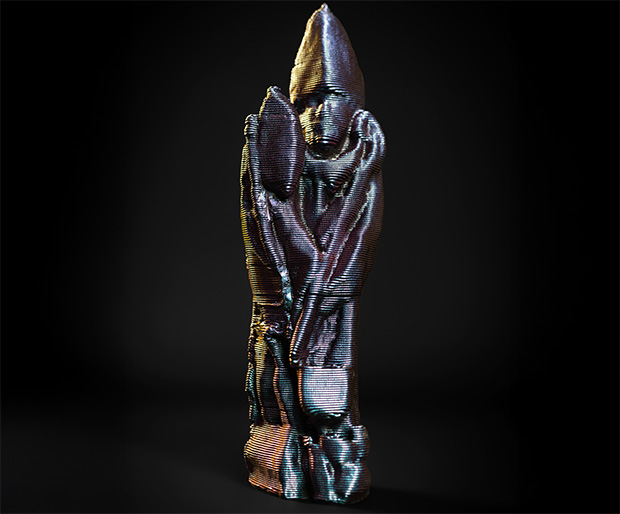
St. Wolfgang, 2024, ceramic 3D print/lacquer, 48×13×13 cm
With ceramic 3D printing, I build a bridge between innovation and traditional craftsmanship. Each finished sculpture is the result of a long process of artistic development. A detailed description of the technique and approach can be found here:
St. Wolfgang, 2024, ceramic 3D print/lacquer, 48×13×13 cm
Marion Abate drew on historical depictions of the saint and combined them with a contemporary production method. She first shaped a 50 cm high statue in clay. This was then further developed in a 3D program and produced using a ceramic 3D printing process. The resulting reduced form deliberately references the stylized figures found on the façades of medieval cathedrals.
St. Wolfgang by Marion Abate is equipped with his typical attributes – the bishop’s insignia mitre and staff, as well as the church and axe from the Wolfgang legend. According to the legend, St. Wolfgang built a church at the spot where the axe he had thrown landed. It is located at „Wolfgangssee“ in Austria. The saint is also known for his care for the poor and his dedication to education. For this reason, the sculpture also includes a book and loaves of bread.
Marion Abate deliberately avoided detailed modeling, allowing the 3D-printed ceramic to speak through its reduced form and distinctive tactile surface. In addition, a flip-flop lacquer creates an eye-catching effect: depending on the viewing angle, the figure shimmers in changing shades from violet to blue to green.
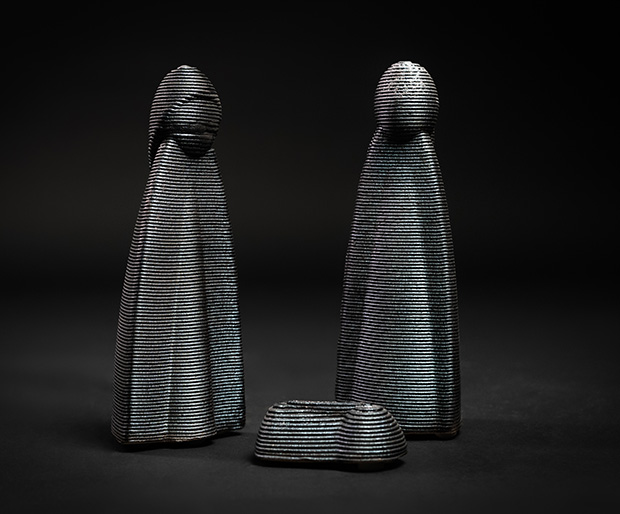
The Holy Family of the Future, 2024, ceramic 3D print/lacquer, 16.5×20×9 cm, limited series
This ceramic 3D-printed sculpture reinterprets the traditional nativity scene with a futuristic aesthetic. By combining innovative technology with ceramic craftsmanship and a metallic shimmering finish, the work transports the classic Holy Family into a vision of the future. Its minimalist design language and sterile, almost technological appearance invite reflection on the meaning of family and spirituality in an increasingly digital world. The reduced representation draws attention to the universal message of togetherness, comfort, and hope – timeless values that remain relevant.
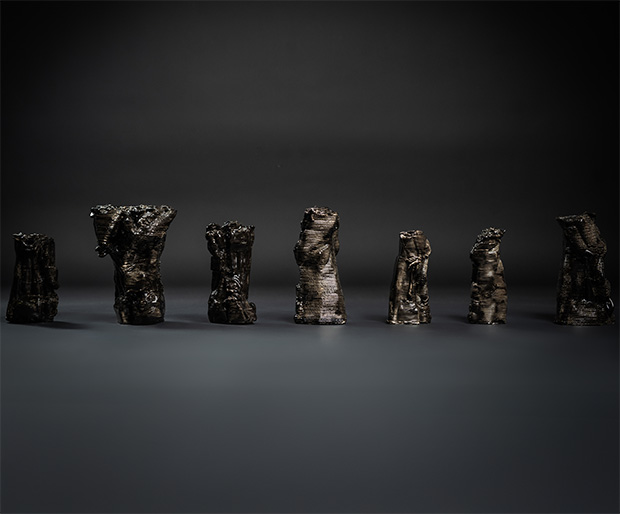
The Process of Failing, 2024, ceramic 3D print/glaze, 16.5×20×9 cm
The Process of Failing is a sculptural series that emerged from an intense, almost analytical process. Originally conceived as a technical experiment it documents the artist’s persistent efforts to realize a figure – the so-called “Saint Wolfgang” – using a ceramic 3D printer. However, over the course of several weeks the printer failed to execute the form precisely again and again: it would not start at all, the clay-built figure collapsed at a certain height or the printing process broke off unexpectedly.
Instead of seeing these breakdowns as mere setbacks Marion Abate shifted her perspective and transformed the flawed into an aesthetic narrative of its own. She collected the deformed, failed prints – misshapen, fragile and unpredictable – and presented them as autonomous works of art. Together they form a kind of sculptural log of failure – a visible line of trials, ruptures, repetitions and the stubborn persistence of artistic pursuit.
Formally the small objects speak the language of the unfinished and fragmented. Each piece bears traces of both technical and emotional struggle. The series raises questions about control and the loss of control, about the relationship between human and machine and about the creative potential of failure.
Artistic Statement:
The Process of Failing addresses not only failure itself but also the process of learning new technology, the emotional side of experimentation and the ability to find meaning in the seemingly worthless. Marion Abate’s work advocates for embracing the process, accepting mistakes and discovering the aesthetics hidden in the resistance of the material.
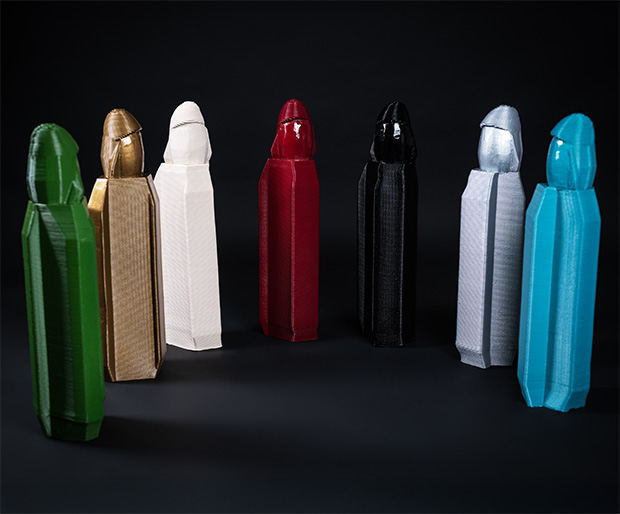
Dialog der Kontinente, 2025, keramischer 3D-Druck/Lack, 48x86x41 cm
Marion Abate’s sculptural work Dialogue of the Continents poses the question: “When will be peace on Earth?” Her answer: through dialogue, communication and mutual understanding – without violence. This message is embodied in seven sculptural figures, each representing one continent and symbolizing its people.
Using ceramic 3D printing combined with hand-finishing, Marion bridges modern technology and artistic individuality. The minimalist, limb-less figures (each 86×48×41 cm) create space for all people and highlight shared humanity.
Each color reflects a continent’s identity: black for Africa (origin of humanity), gold for Asia (spiritual and cultural richness), purple for Europe (power and art), green for North America (growth and ambition), turquoise for South America (vitality and indigenous heritage), ochre for Australia (Aboriginal culture), and silver for Antarctica (purity and isolation).
The figures can be arranged freely – in a circle for dialogue or in other constellations – inviting reflection on coexistence and peace. Inspired by the founding words of the World Council of Churches – “War shall not be for God’s sake” – Marion expands the call to global peace beyond any founding nations. Her work reminds us that humanity is equal in its diversity. Peace begins with understanding – before conflict becomes violence. These reduced but expressive forms ask us: How do we meet one another? How do we build peace together?
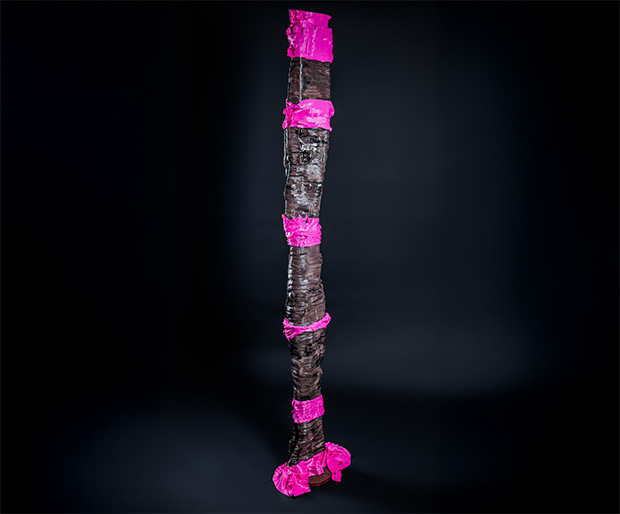
Synapses, 2025, ceramic and polymer-based 3D print, 180×37×25 cm
Synapses is a 1.80-meter-tall sculpture that explores an innovative combination of ceramic and polymer-based 3D printing. This unique composition visualizes the interconnectedness of the two printing methods and serves as a symbolic link between the digital and physical worlds.
The title refers to the biochemical connections between nerve cells that enable communication. Here, this principle is transferred into the realm of art and three-dimensional space. The contrasting materials act as metaphors for the dialogue between digital and real spheres. The sculpture’s organic form reflects the complexity and sensitivity of neural networks and invites viewers to reflect on the interaction between technology and physical presence.
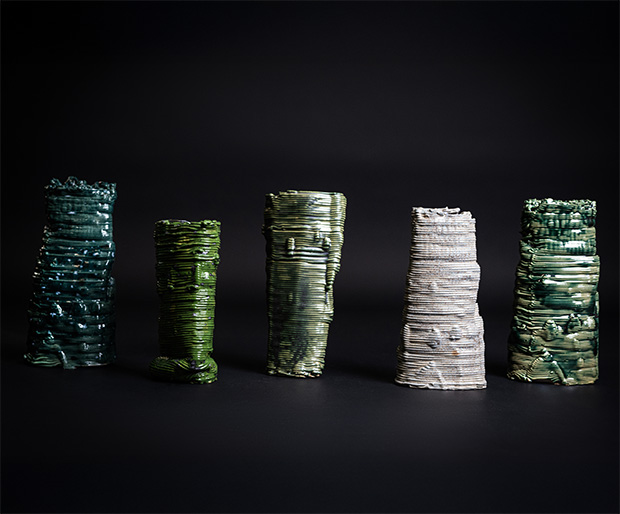
Luminous Growth 2.0, 2025, ceramic 3D print/glaze/LED, 25×38×35 cm
In Luminous Growth 2.0 (2025), Marion Abate revisits the theme of organic upward growth, building upon her earlier 2015 work Luminous Growth. While the earlier sculpture explored inner light using wax and integrated POF fibers, the 2025 piece embraces ceramic 3D printing to further investigate formal dynamics and the notion of expansion.
Each fantastical plant form appears with a unique visual language and coloration, while sharing a common aesthetic. Visible print layers are deliberately retained and integrated into the overall composition, highlighting the interplay of craftsmanship and technological innovation at the core of this sculptural technique.
